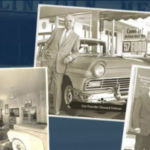-
What We DoFrom fleet management and productivity solutions to upfitting, fabrication, and insurance, Holman has the integrated automotive services expertise to keep your business moving.Overview
-
ResourcesWe have a lot to share. Browse our resources library for current insights, data, strategies, and success stories from our own experts in their respective fields.Overview
-
About UsWhen Holman was founded in 1924, we set something positive in motion. Our consistent focus on people and our commitment to integrity make us who we are today.Overview
 Join Our TeamWe’re not just in the automotive business, we’re in the people business. Join us for the ride.Browse Careers
Join Our TeamWe’re not just in the automotive business, we’re in the people business. Join us for the ride.Browse Careers
Fleet Procurement Tips From Holman

Coping with Complexity: Fleet Procurement Tips from Holman
Fleet costs are a significant expense for every business, and with finances so stretched, companies are doing everything they can to cut costs. But sometimes, selecting the cheapest deal on paper may turn out to be more expensive over its full duration.
As well as keeping control of finances, fleet operators must make decisions in an increasingly complex environment, with changing consumer demands, new regulations, and sustainability concerns adding to the challenge.
Here are some hints and tips from Holman experts to help ensure you get the fleet you need to deliver for today and tomorrow.
Building a Fleet
On the surface, buying a fleet of new vehicles should be simple. You find the vehicles you want, agree on a price, and purchase them. But the reality is the opposite.
Fleet operators are often given a base price for a vehicle by a provider, which is used as the basis for budgeting and forecasting. But, when you start defining specifications, this cost can rapidly increase – adding hundreds and even thousands to the bill for each vehicle.
Identifying the best price is tough. Fleet buyers often find that manufacturers regularly offer discounts and raise prices, meaning it can be hard to identify a competitive price. Changing interest rates means borrowing costs can change monthly, with even a fraction of a percentage point adding significantly to borrowing costs. This is all before considering service, maintenance, and repair add-ons.
As well as upfront costs, operators must consider ownership and disposal expenses. Rate creep – including end-of-contract charges, early termination fees, and damage waiver costs – can increase costs dramatically, but may remain hidden in the initial stages of the contract.
It’s clear that fleet managers are making high-pressure decisions with imperfect information. Instead of jumping into contract negotiations, fleet operators should start with what they do know – and identify their needs.
Start With Your Needs
Before identifying vehicles or engaging providers, you need to build a clear picture of your requirements. This involves thinking about your fleet strategically, ensuring you have the vehicle size and type you need for the short- to medium-term.
At Holman, we start with a blank sheet of paper, working to understand your business, aims, and objectives and build a fleet package that’s bespoke to you.
In some cases, if you’re happy with the service you’re receiving, sticking with your current supplier can be tempting – especially considering the time, cost, and inconvenience of a formal tender. Even so, you should approach each negotiation with the mindset of a new client and push for the best deal possible.
Price is a crucial factor, but it shouldn’t be the only one. Working through the tender process can help you identify what matters most to you. While upfront costs are important, you must consider every aspect of your fleet agreement, including servicing and maintenance, excess mileage, and end-of-contract fees.
The world is increasingly unpredictable, with businesses facing a raft of new regulations and costs that are impacting fleets.
The solution? At Holman, adaptability is built into our finance lease packages. Operators have the freedom and confidence to always have access to the vehicles they need. As well as day-to-day activities, flexible lease agreements enable businesses to manage the transition to sustainable energy sources.
Whether you choose to work with your incumbent provider or go out to market, here are 10 tips to help you get the best result for both partners.
10 Tips for a Better Fleet Procurement
- Pre-contract: Set out the scope of negotiations and engage with several suppliers. You don’t need to commit to providers, but initial discussions can help you identify those you want to engage.
- Set boundaries: Before negotiation, establish the roles and responsibilities of each side, including setting out timescales for responses and any flexible and fixed deadlines.
- Define contract award criteria: While staying on top of costs is critical, it shouldn’t be the defining factor. Consider overall contract costs, service levels, and customer experience in your award criteria. The cheapest provider is rarely the best provider.
- Create a clear contract: Your contract must set out the roles and responsibilities of each side and provide clarity on all costs. To avoid conflict down the line, ensure that you’ve covered everything.
- Stay in touch: Your fleet requirements and service requirements will change, so stay in touch with your supplier. Schedule regular calls to check in, with more in-depth face-to-face meetings a couple of times a year.
- Review your service: Ensure that you’re getting the service you pay for by reviewing your experiences and ensuring they’re in line with your contract.
- Dig into data: Data can help you to manage your contract, identifying areas for improvement. Use this data to improve utilisation, manage driver behaviour, and protect your vehicles.
- Collaborate with your fleet provider: There will be issues in your contract (nobody is perfect!), but collaboration can help you identify solutions together.
- Build a personal connection: Your deal is with a company, but your connection is with real people. Building a personal connection with your contract owner will help you when dealing with difficult circumstances and changing conditions.
- Focus on the future: Your contract defines your ongoing relationships. During the lifetime of the contract, things will inevitably change on both sides. Focusing on the future will ensure your fleet remains optimised for your operations.
Build a Fleet Procurement Partnership
Fleet providers are suppliers – but the best ones become partners who are as passionate and invested in your success as you are.
At Holman, we focus on ensuring you’re driving what’s right – creating the optimal vehicle mix for changing circumstances. Whatever your plans and priorities, Holman is your ideal fleet partner.
Learn more today.
Next Post
Holman Opens Birmingham OfficeRelated Resources
Explore more related industry news, insights, and developments.
It looks like you've navigated to our Holman UK website and are located outside of this region. Would you like to continue or select a different region?
✕






